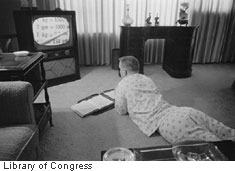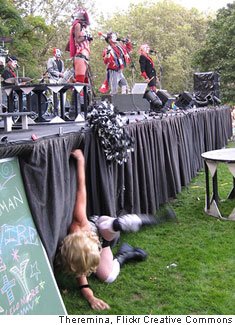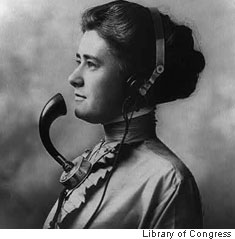This time out, I want to explore some aspects of American culture. Not the flute-recital kind, though I’ve long thought of culture in that regard. Rather, a glance at several other aspects, some of which aren’t cultured at all.
 |
| Pop culture’s not quite like this. Although, come to think of it, sometimes people in it don’t wear many clothes, either |
There’s also something called “popular culture” that, we’re told, appeals to “the masses.” We’re definitely not talking flutes there. Pop culture is hard to define, but it certainly embraces escapist movies and hit music, fan magazines and ever-expanding varieties of sports, plus some activities that are neither elevating nor especially enlightening. Soft and hard-core pornography, for example; violent, misogynist urban music; and insipid television shows. All the while pop-culture diversions consume our attention and dollars, sources of at least moderate erudition are diminishing in influence. Newspapers, for instance. They even covered the occasional flute recital.
When I first switched from print journalism to broadcasting, it was explained to me that television, in particular, wasn’t a highbrow medium, and I shouldn’t expect it to be. “The tube’s” programming was sugar and spice, not fiber – filling but hardly nutritious and aimed at the “lowest common denominator” among us. Whatever generates the highest ratings, slips even just a whisker above the bar of good taste, and attracts the most advertiser dollars is fine with us. Interesting concept, that “lowest common denominator.” The term comes from mathematics, where the lowest common denominator is “the least common multiple of the denominators of a set of vulgar fractions.”
If vulgarisms are good enough for arithmetic, they’re good enough for the “Morning Zoo” on the radio and “comedy” shows on TV.
 |
| Television was going to be a great educational tool. It’s teaching us things, all right |
Standards have been diminished to the lowest level that will reach a palatable, unremarkable, “common ground” of interest among the most possible people. And the level of what’s acceptable keeps falling. Since everybody stares at highway wrecks, we’ll program police chases and car crashes! Since everybody on cable has a potty mouth, but there are certain words we can’t say over the air, we’ll joke about bodily functions and sexual dysfunctions instead. We’ll put on the overwrought love stories that we call “soap operas” day and night. Hey, opera is cultural!
Go ahead, say the producers and their financiers. Demean “trash TV.” But you’ll watch it.
 |
| This was an early set of “America’s Funniest Home Videos.” Fun! Balloons! $100,000! |
“Pop culture” and “culture culture” sometimes converge. This was evident the other day when the National Museum of American History, one of the storied Smithsonian Institution museums that line the National Mall here in Washington, welcomed into its collection priceless objects from the 20-year-old TV reality show “America’s Funniest Home Videos.” Yes, my tongue was in my cheek about the “priceless” part.
 |
| Juggler. Dog on head. Could be a winner! |
What a concept that show introduced to the country! You make “home movies,” but not boring stuff like Cousin Sue’s passing the potato salad at a picnic. No, you wait for the kids or the pets or visiting relatives to act stupid or go wild. Stage something if you have to. Pratfalls are good. Wet cats and eating contests work. Dogs running into things. Then rush us the tape. Who knows? You could get on TV and win money! Disastrous developments involving weddings, animals and pets, and babies are such sure-fire laugh engines that they have their own categories. “Baby farts a cloud” of talcum powder was one illustrious example. What mirth that brought the nation! And mom and dad got on TV and won money!
 |
| Is it worth lighting the powder to get on TV? |
So what if an amazon.com compilation of “America’s Funniest Home Videos” is entitled, “Nincompoops and Boneheads.” We weren’t getting on TV and winning money being Ma and Pa Homeowner alone. Let’s have Uncle Martin catch his pants on a nail and run down the street in his underwear! Then we can be famous nincompoops getting television face time and cash!
Lowest-common-denominator stuff, dumbing down both television and the “culture.” Not just ours. “America’s Funniest Home Videos” is now seen in more than 70 countries and produced in 15 international versions. Who says we have an export problem?
 |
| The first of many Smithsonian Institution Buildings, called “the Castle,” once held the whole collection, from elephant tusks to everyday ephemera |
The United States Congress created the Smithsonian Institution in 1846, naming it after the British scientist James Smithson, who had died 20 years earlier. Smithson, who had never visited America, mysteriously left his estate to the United States to establish an institution that would, in the words of his will: “increase and diffuse knowledge among men.”
 |
| Here are some of the items that will become part of the American History museum’s “Funniest Home Videos” collection |
That knowledge, the Smithsonian now wants us to believe, was “increased and diffused” by the addition of an “America’s Funniest Home Videos” camcorder, the first winning video to be shown on the show, a machine that the studio audience uses to pick winners, and more. The items were presented to the Americana museum by Vin Di Bona, “Funniest Home Videos’” creator and executive producer, whose other TV triumphs include “Battle of the Network Stars” and “Entertainment Tonight.”
 |
| Believe it or not, the Smithsonian’s American History museum’s holdings include a small stretch of Old U.S. Route 66 – concrete, cracks, and all |
To be sure, the National Museum of American History has never been terribly stuffy. Its collection does include U.S. First Ladies’ gowns, the flag that flew over Fort McHenry in Baltimore when Francis Scott Key scribbled the words to our national anthem, World War II ration books, plus early automobiles, clocks, engines of various sorts, and household appliances. But it also houses daredevil Evil Knievel’s Harley-Davidson motorcycle, a Kermit the Frog puppet from the children’s show “Sesame Street,” the ruby-colored slippers worn by Judy Garland in the movie “The Wizard of Oz,” a gumball machine featuring a likeness from the early Pac-Man video game, and Archie Bunker’s easy chair from the TV show “All in the Family.” Bunker was the bigoted, loudmouthed, but warmhearted lead character.
 |
| Band member falls offstage. This could be big. Did anybody catch it on camcorder? |
Now, at last! tourists visiting the museum can see the first episode of “America’s Funniest Home Videos,” in which a man tumbles off exercise parallel bars, a bride falls on her face while dancing, and a baby licks the camera lens! The show hadn’t found its oeuvre yet. The genius of inadvertent kicks to the groin and baby farts with talcum powder was yet to come.
“One of my thrusts has been to collect artifacts of comedy,” noted Dwight Blocker Bowers, the museum’s curator of music, sports, and entertainment. “We’re very interested that part of the American character is laughing at ourselves.”
Don’t get me started on the “American character.”
 |
| Of late, Newton Minow, now 83, hangs out in Chicago, where he’s honorary consul general of Singapore |
In 1961, Newton R. Minow, the chairman of the Federal Communications Commission, which regulates television and other broadcast media to a minimal degree, delivered a speech for which he is still remembered. That’s because the relevance of his remarks has intensified with time. That day 48 years ago, he said:
“When television is good, nothing — not the theater, not the magazines or newspapers — nothing is better.
“But when television is bad, nothing is worse. I invite you to sit down in front of your television set when your station goes on the air and stay there, for a day, without a book, without a magazine, without a newspaper, without a profit and loss sheet or a rating book to distract you. Keep your eyes glued to that set until the station signs off. I can assure you that what you will observe is a vast wasteland.”
 |
| Ah! The substance of much TV fare, captured in one photograph! |
Wasteland then. Source of carefully cultivated refinement today. Consider the 10 top-rated U.S. TV shows for the week ending April 5::
(1 and 2): The Tuesday and Wednesday airings of “American Idol,” in which thousands of unknowns sing, some get savagely ridiculed, and the winner gets a big recording contract. (3) “Dancing With the Stars,” in which celebrities – often sports notables – sashay around a ballroom with professional dancers. (4 and 8) “NCIS” and “CSI,” two shows involving scientific investigation of dastardly deeds (5) “The Mentalist,” in which a psychic helps the white-lab-coat crowd solve crimes (6) “ER,” a rather bloody emergency-room drama (7) a country-music awards show (9) “Two and a Half Men,” a comedy about a “freewheeling,” hedonistic bachelor, his divorced brother, and his “underachieving” nephew, and (10) a college basketball tournament game.
Some day, if he’s still at his post, curator Bowers can add artifacts from these shows to the nation’s Americana collection.
We Don’t Want No Knowledge
For about a year I’ve held onto a New York Times clipping whose content seems to fit perfectly here. Entitled, “Dumb and Dumber: Are Americans Hostile to Knowledge?” it’s a story about Susan Jacoby, a scholar of American intellectual history, and her book, The Age of American Unreason.
 |
| Magnificent Budapest, the capital of Europe! |
The story’s writer, Patricia Cohen, described two truly humiliating examples of the woeful ignorance that many Americans exhibit when it comes to events beyond their noses. In one, a contestant from “American Idol” appears on the TV game show “Are You Smarter Than a 5th Grader?” – a risky premise if there ever was one. She was asked, from a third-grade geography book, “Budapest is the capital of what European country?” Her answer: “I thought Europe was a country.”
Guffaw.
Then in the Times story, Jacoby described overhearing a conversation in a New York bar on September 11, 2001, the day that terrorist-piloted planes leveled the twin towers of the World Trade Center.
“This is just like Pearl Harbor,” she heard one of the men say.
 |
| The Pearl Harbor attack did occur in a harbor. But half an ocean away from Vietnam |
“What is Pearl Harbor?” asked the other.
“That was when the Vietnamese dropped bombs in a harbor, and it started the Vietnam War,” came the reply.
Ignorance used to be bliss. Now it’s just ignorant.
 |
| Spiro Agnew, who needled the media with zippy putdown lines, once said, “If you’ve seen one city slum, you’ve seen them all.” |
The ‘nattering’ quote was uttered by President Richard Nixon’s vice president, Spiro Agnew, who was speaking in 1970 about “eastern effete” members of the media. Agnew, a former Maryland governor, was a rumpled and, we all soon learned, corrupt man who had also opined that an intellectual is “a man who doesn’t know how to park a bike.” He did not share his views about women and bikes.
 |
| De Tocqueville expected to find a backward country but came away from his trip stunned by Americans’ drive and grit |
A VOA colleague with whom I shared some of my disillusionment about popular culture did not call me a nattering nabob or a poor bike-parker to my face, but she did remind me that cultural pessimism is hardly new or revolutionary. Nineteenth Century French statesman Alexis de Tocqueville, after a long expedition across the young United States, concluded that we were a shallow, restless, ever-changing, money-driven lot. And my friend pointed out that our newspapers once produced sensationalist and scurrilous “yellow journalism” of little substance, our early television brought us such classics as “The Beverly Hillbillies,” Elvis Presley was denounced in his day as someone whose pelvic gyrations might bring down the republic, and whose rock-‘n’-roll music would ruin the entire world.
Some of today’s rappers have demonstrated keen insight into the human condition, she pointed out. Television has hundreds of channels whose intellectual fare would impress a Rhodes Scholar, and the Internet has put us in contact with concepts and cultures that some of the smartest among us never knew existed.
Cultures like you find in that country over there. Europe.
We’re On Our Own
Washington Post columnist John Kelly recently profiled what surely must be one of the last elevator operators in the area. Charlie Patterson was retiring after 44 years of manually closing the elevator door and yanking the control lever that directed the cab to various floors. Most Americans over 60 remember nattily attired elevator operators in big office buildings and department stores. They were virtual tour guides: “Six! Ladies’ apparel, sportswear, costume jewelry,” they would cry out.
 |
| This elevator operator in Washington’s Barr Building was caught on film in 1941, the very year VOA’s elevator ops began their work across town |
Here at the Voice of America’s headquarters building, just off the National Mall in Washington, some old-timers dimly remember operators on duty inside our nine gleaming, polished-brass elevators. I found two women who worked as clerks in the building shortly after it opened in 1941 as the temporary home of various War Department branches and commissions. One of them, Marjorie Downey, remembers these “lift” operators – along with cafeteria workers – as some of few black faces seen in the building in those highly segregated days, when we also had separate sets of bathrooms for whites and “Negroes.” These operators wore crisp, maroon uniforms with white shirts and ties, Marjorie recalls. She can even quote what she calls “their standard phrase”: “All the way to the back and face the front!”
And since the building was full of military types, people no doubt did what they were told.
What really caught my eye was Kelly’s aside that, in the years since Charlie Patterson first ran elevators in Washington’s Ring Building, “we’ve gotten used to doing things for ourselves – things that others once did for us.” Besides running our elevators way back when, he noted, someone pumped our gas, bagged our groceries, and “rang up” our purchases at the store.
Kelly’s list can be greatly expanded. While Americans think of ourselves as pampered, speed, convenience, and, especially, cost-saving have imposed self-reliance upon us. My Miami friend, Marc Kuhn, helped me compile some examples:
 |
| Note the relaxed driver, foot on the rear bumper, watching as someone besides himself pumps his gas |
• We pump our own gas. I can’t remember the last time anyone spoke these words: “Check your oil?” Forget cleaning the windshield. You’re lucky to find your own vat of dirty water and a torn squeegee wedged between the pumps. This may be the one and only reason I love the State of New Jersey. There by law, only attendants may pump gas, yet the price somehow manages to be cheaper than in the surrounding states.
 |
| Sometimes it took three or four switchboard operators to get your call from one part of the country to another |
• Where an elite corps of “long-distance operators” once placed all of our out-of-town telephone calls, we now do our own with the push of 12 or 13 buttons. Delivery people used to bring us our milk, bread, pastries, clean laundry, and, to some houses, coal. Now we schlep out and get these things ourselves. And of course we make our own ice; no one that I know of hoists blocks of it on his shoulder, using unwieldy tongs, any longer. If we get a hankering for a sweet ice confection called a “Popsicle” – or a Creamsicle with a dab of filling or an “Eskimo Pie” ice-cream bar – only a drive to the supermarket or “convenience” store will satisfy it. The white trucks of “Good Humor men,” with their tinkling bells and freezers full of treats, are a rarity, although I’ve heard there are some “Mr. Softee” trucks still around.
• Most of us book our own airplane reservations and buy and print our tickets, rather than relying on airline or travel agents. Airlines, in fact, charge us extra if we ask them to do it. We scrounge for most of our own motel and rental-car reservations, maps and directions, and theatre and sports tickets online as well.
• We mostly pick out our own clothes, including shoes, on the Web or from piles on tables in stores, rather than enlisting the counsel of suave sales personnel and tailors. And if we find a grocery-store clerk who knows where to find the peas, or someone in a work apron in a home-improvement store who can navigate through 400 kinds of screws, we’re giddy with joy.
 |
| Not only do scanners “ring you up” at the checkout counter, but now there are devices that customers carry down the aisles to record purchases as they go |
• There are still checkout cashiers, but more and more store lines lead to unmanned machines. Like dutiful ants, when we reach them, we scan our own crackers or minestrone soup or fresh avocados, and then bag ‘em ourselves. I, for one, defeat the store’s best labor-saving intentions. Staring at the evil, blinking, beeping beast of a machine, I grow hopelessly confused, mistaking arugula for bibb lettuce and entering entirely the wrong code, thus requiring the assistance of an understanding clerk after all.
• Physicians – and TV repairmen – used to come to our houses! Now it takes an executive order, or two weeks’ notice, to get an appointment at the doctor’s office, there to wait another hour next to other sick people, beneath the scowls of the office staff, who must not be disturbed while they enter various billing codes for the “treatment” other patients have been privileged to receive. By the time you get in, you’re well! As for TV service, when a set breaks down we mostly junk it, go to a “big box” electronics store, buy a bigger one, somehow lift it into the trunk, tie it down with a piece of greasy rope we found under the tool kit we’ve never opened, and lug it home.
 |
| Lemme tell you: This doesn’t look like the lunch places across from VOA. They’re strictly pay-up-front and pick-up-your-food joints |
• Waitresses or waiters used to bring us our coffee or sandwiches at lunch counters or diner booths. Now we stand in line to pay $4 for a barista-brewed Cup of Joe, buy sandwiches out of a machine or from a vendor, and, as often as not, eat lunch at our desks. Lunch places still have tables, but increasingly you go get your own food and beverage at a counter, pay for them, and bring them there.
• And speaking of service, I’d like to know the last time anyone found a strolling cigarette girl, a nightclub photographer, or a shoeshine boy. (Never saw a shoeshine girl.) Now we bring own tobacco products, take our own photos – on our cell phones! – and polish our own shoes.
• Tellers took our money, or gave us some, at the bank. Now, “automated teller” machines do most of this, and different machines count and deposit our loose change. We don’t tote our paychecks to the bank. One computer at the office whisks our meager earnings via still more computers straight into our accounts.
• Not just top executives but also mid-level professionals used to employ the services of their own secretaries or, at a minimum, clerks in the “typing pool.” Now the word “secretary” is an epithet, beneath the dignity of the boss’s “executive assistant.” Call her – or him, he said, enlighteningly – a secretary, and you’ll be brought up on charges. We type our stuff, do our own research using computer search engines, and buzz our own way into buildings that long ago eliminated their “front desk” personnel. Usually, too, we open our own doors – “doorman” being another fast-disappearing occupation.
 |
| Do this! Do that! And don’t expect me to do it for you, bud |
So we’re not so pampered after all. And one of the results is that we sometimes feel like the ball in a pinball machine, whacked here and there amid a lot of noise. If we’re lucky, we schedule some contemplation, maybe on a vacation whose arrangements we make for ourselves. I don’t mind pressing my own elevator button, or opening my own door, or typing this blog for myself. But writing about all this makes me want to pack the car and hit the road. For New Jersey, where someone might ask me, “Check the oil?” once again.
Vision of Things to Come?
One of the recent “Bizarro” cartoons by the brilliant Dan Piraro showed a reasonable likeness of New York City’s central library, with its lofty set of stairs, regal columns, and sentinel lion.
Out front, Piraro drew an ornate stone tablet into which is chiseled:
MUSEUM OF THE INTERNET
Formerly the New York Public Library
(These are a few of the words from this posting that you may not know. Each time, I’ll tell you a little about them and also place them into a cumulative archive of “Ted’s Wild Words” in the right-hand column of the home page. Just click on it there, and if there’s another word in today’s blog that you’d like me to explain, just ask!)
Cup of Joe. A cup of coffee. The term could relate to the average American – the “average Joe,” or perhaps it dates to World War I, when U.S. admiral Josephus Daniels broke with naval tradition by banning alcohol, including wine in the officers’ mess, aboard American ships. Thereafter coffee – deridingly called a ‘cup of Joe – was the strongest brew on board.
Guffaw. A boisterous laugh.
Highbrow. Having or demonstrating culture, refinement, and taste.
Nabob. Originally a Mogul high official, the term came to be associated with executives of the British East India Company and, later, of any highly placed – and perhaps a tad pompous – individuals.
Nattering. Chattering, usually about things of little importance.
Oeuvre. A work, or life’s work, of art, music, or film. This word is often used somewhat pretentiously, since “one’s oeuvre” sounds terribly cultured.
Pratfall. An often humiliating slip or fall, fast, onto one’s backside. “Prat” was an Old English term for one’s buttocks.
Schlep. From Yiddish: to tediously drag oneself someplace.









One response to “Culturating”
Yes! I agree what you say!Oakley sunglasses, Chanel Sunglass, Chanel shoes .